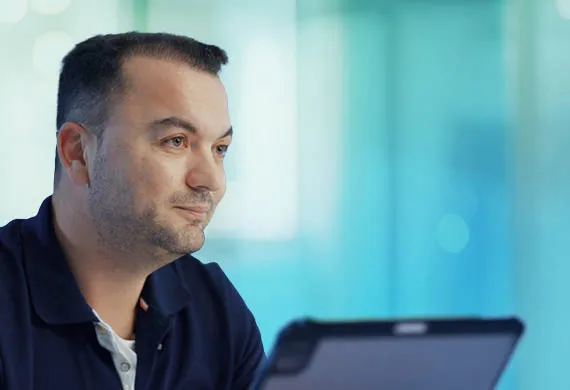Integrate Circularity into Product Design to Reduce Environmental Impact
Products designed for circularity are pivotal in shaping the environmental impact for generations to come.
Do you know the environmental impact of the products you make and consume?
According to The World Counts, around 2.12 billion tons of waste is dumped on the planet. E-waste alone accounts for 50 million metric tons of waste generated globally every year, as outlined by Statista. But as landfills run out of space and consumers call for more sustainable goods, companies are urged to consider a product’s environmental impact during its use and, eventually, its end of life. Every product we make and use should no longer be a commodity but a catalyst for change.
Environmental regulations like France's repairability index are paving the way for a durability index by 2024 to measure product longevity. Regulations like these call for products that are designed not only for functionality and aesthetics but also for repairability and durability. Why is this important? Designing products so they may be reused ensures materials stay in the loop for as long as possible while generating value for you and your customers.
Design for the Entire Product Lifecycle
Designing for all product lifecycle phases takes into account the environmental impact of a product, from the extraction of raw materials to its end-of-life. This approach requires a holistic view of the product lifecycle, which includes the following phases:
- Raw material extraction and processing
- Product design and development
- Manufacturing and production
- Distribution and logistics
- Use and maintenance
- End-of-life management
By optimizing product design for each phase, companies can reduce the environmental impact of their products and increase their circularity.
Incorporate Eco-Design Principles to Boost Sustainability
Based on research by UN Environment Programme (UNEP), decisions made during the design stage can influence a product’s environmental impact by up to 80%. Eco-design principles are at the core of a circular product lifecycle. By incorporating these principles into product design, you can extend the lifespan of your products and reduce the need for frequent replacements.
The virtual twin makes it easier to visualize how eco-design principles can be applied effectively. Imagine being able to test multiple what-if scenarios through a wide range of simulated settings, including drop tests and sustainable materials. All before execution in the real world.
Are you looking to quantify the environmental impact of your product? With a holistic view of the product lifecycle, you can perform life cycle assessments (LCA) to assess the product's environmental impact — from material selection, manufacturing, distribution, use, repair and maintenance, and disposal or recycling.
Interested to get to know our experts featured in the videos? Meet them here
Design for Repair and Disassembly
Imagine being able to simulate the dismantling process and identify ways to improve the recovery of valuable materials. Let’s look at smartphones. If you want to design a more repairable phone, simulation on the virtual twin helps you confirm that the screen can be taken out without causing any damage, simulate potentially harmful actions like removing a phone battery which if not handled properly, can cause a leak of toxic electrolytes. This is why designing for disassembly is fundamental to circular economy thinking.
With the virtual twin, you can rethink your product design from the ground up and encourage circular product design, ensuring that products are easy to assemble and disassemble. This promotes the recovery of valuable components and materials at the end of a product's life, reducing and recycling waste and conserving resources.
How One Industry Leader Is Decarbonizing Processes By Improving Part Reuse
By implementing circular economy practices empowered by Dassault Systèmes’ innovative solutions, a major equipment manufacturer was able to mitigate risks, decarbonize processes and successfully reduce scrap and waste.
Turn Circularity Thinking Into Action
In today’s take-make-waste world, the need for circular practices has never been more critical. To truly embrace the circular economy, you must consider the entire product lifecycle, from inception to disposal. This requires a fundamental shift in how products are designed, produced, used, and disposed. The role of sustainable product design is crucial, as it determines the environmental impact of a product throughout its lifecycle.
Opt for the right circularity strategy that prioritizes environmental impact and secures measurable results. With a holistic approach to product design, you’re not just making the circular economy achievable; you’re making it desirable. Together, let’s forge a path toward a circular world.
More Questions on Circular Product Design?
Unfortunately, no, because 80% of the product's environmental impact is defined during the engineering phase.
During product development, performance is defined, specifically during the engineering phase when it's decided what will be recycled and how. Therefore, it would be complicated to go circular by only changing manufacturing processes.
Nevertheless, a change in manufacturing processes is required to close the circularity loop — being able to refurbish, reuse and recycle and recover parts to reduce material usage. This requires new manufacturing processes to disassemble, test, service and recover raw materials that are not part of the current linear production model.
In the past, the evolution of manufacturing processes was due to cost. Today, manufacturing is driven by an acceleration of raw material costs, scarcity of goods, increased energy costs, environmental regulation restrictions and geopolitical instability. These drivers will push manufacturing processes to lower production costs and resource dependency and comply with regulations, which reduces the effects of geopolitical instability.
In the coming years, products designed for circularity will be automatically disassembled by line machines into recycle, reuse or refurbish streams that could still be used in the next assembly.
To become more sustainable, you first need to understand sustainability—and this is where data science plays a crucial role. By connecting data with business, companies gain a comprehensive view of their environmental footprint, not just for their products but also for manufacturing processes and product usage. A 360-degree perspective helps assess the full impact of their activities and identify opportunities for improvement. With these insights, companies can pinpoint the most effective strategies to enhance sustainability.
To learn more, listen to our data science specialist, Diana Goenaga, as she uncovers what it takes to lower the environmental footprint of products — one of many big questions on the minds of business leaders today.
Digital transformation is the key to innovating for sustainability. It's a process of integrating digital technologies into various aspects of your business to enhance operation, reduce environmental impact and create value.
First, it is about data-driven decision-making. Digital transformation empowers organizations with real-time data and analytics. By harnessing this data, companies can make informed decisions with sustainability initiatives, track progress and optimize resource usage.
The second point is about efficiency and resource optimization. Digital tools streamline processes and resource management, whether it's R&D, productivity, supply chain optimization, energy management or waste reduction. Digital transformation allows companies to do more with less, cutting costs while reducing the environmental footprint.
The last point is about innovation and product environment. Digital technologies enable innovative and more circular product designs and services that align with sustainability goals. For instance, creating products with longer lifecycles or offering digital solutions to reduce physical resource consumption.
Here are two examples of companies embracing digital transformation for sustainability.
Nippon Shokubai, a global specialty chemical leader, aims to cut carbon dioxide emissions by 30% by 2030 and achieve carbon neutrality by 2050. To enhance efficiency, accuracy, and data integration, the company leveraged modeling and simulation tools, combining computational methods with lab analysis. This approach accelerated product development and improved process efficiency.
Another example is a leading pharmaceutical company that aimed to enhance productivity and speed up product development. By implementing BIOVIA ONE Lab solutions, it tripled process development projects without adding staff and improved efficiency by 60%, saving over $50 million annually.
Digital transformation isn't just a technical operation. It's a strategic move toward a more sustainable and resilient future. It empowers organizations to innovate, reduce costs and lower environmental impact. By prioritizing digital transformation, companies can step into a new era of sustainable business practices, including sustainable design, ensuring long-term success and contributing to a better world.
There is a straight connection between waste and resources: waste could be a resource. Additionally, the relation between waste reduction and margin increase is simple and waste should be disposed of only when there is no other viable solution to transform it into a resource.
For industrial applications, life extension is an easy example of waste reduction. For example, by just upgrading some modules of an assembly line machine instead of replacing the whole assembly line, OEMs can reduce waste while improving competitiveness with a more performant and modernized line. In addition, when the assembly line is replaced with a brand-new line, the old machine could still be sold to companies with less requirements in term of performance.
For this use case of secondhand markets, disassembly procedures, transportation jigs and path traceability would be required to fulfill the reuse operations, considering quality and safety.
Lightweight engineering also plays an important role in circularity initiatives. For example, designing lighter parts using 3D printing, for instance, will allow companies to reduce the amount of raw materials used, but also to reduce part inertia for moving parts, with the consequence of reducing energy costs during the ownership.
The last example we can provide concerns the number of spare parts that, every year, are scrapped due to obsolescence in the warehouses. Optimizing spare parts inventory in the warehouses — thanks to real-time monitoring and predictive maintenance, and using standard parts instead of custom parts to increase reusability — makes it possible to save tons of waste while reducing inventory and obsolescence costs.
Other Circular Economy Pillars
Explore key pillars that are disrupting the conventional linear economy, eliminating value leakage and paving the way for a scalable, profitable and achievable circular economy transformation.
Prioritize Sustainable Materials
The choice of materials can significantly impact your product’s environmental footprint. Incorporate circularity into product development through durable, recyclable and biodegradable materials by design.
Reshape Value Networks
Ready to merge environmental protection with business operations? Move from linear to circular value networks to demonstrate that value creation and profitability are achievable within strong planetary boundaries.
Circular Solutions for Your Business Challenges
Take Definitive Steps Toward Circularity Success
Inspired by actionable strategies from Dassault Systèmes’ industry experts? Dive into our Circularity Insights Digest, your definitive guide to transform circularity goals into scalable, achievable and profitable outcomes.
Circularity in Action
At the core of the concept of circular economy lies the idea of circularity, where resources are kept in use for as long as possible. Real-world adoption of circular economy strategies demonstrates the tangible benefits of this approach. Embracing Dassault Systèmes’ 3DEXPERIENCE® platform allows organizations to reimagine their operations, aligning them with the principles of the circular economy. From design phase to lifecycle analysis, businesses can create products that contribute positively to the green economy while meeting consumer demand for sustainable solutions.





